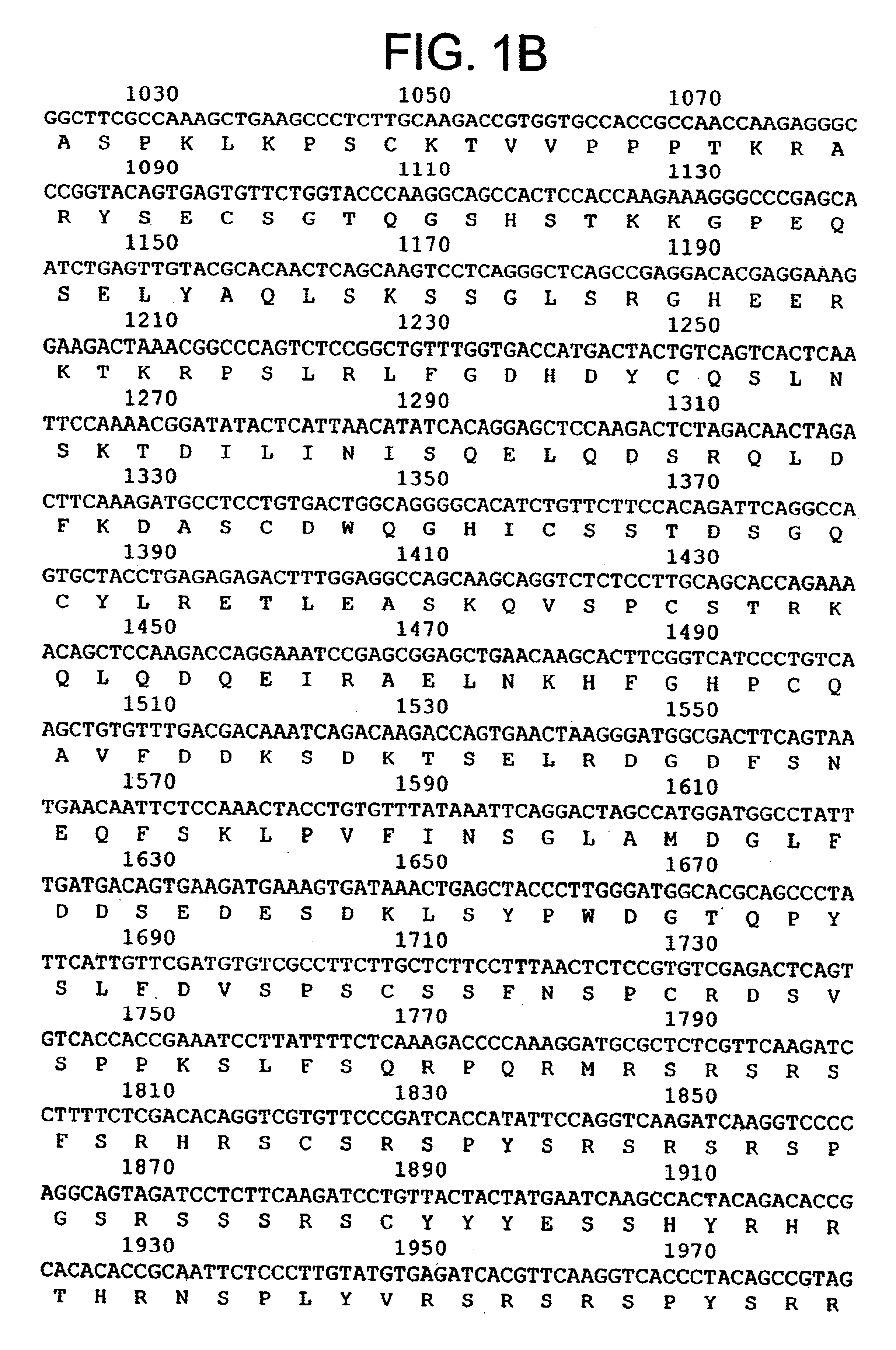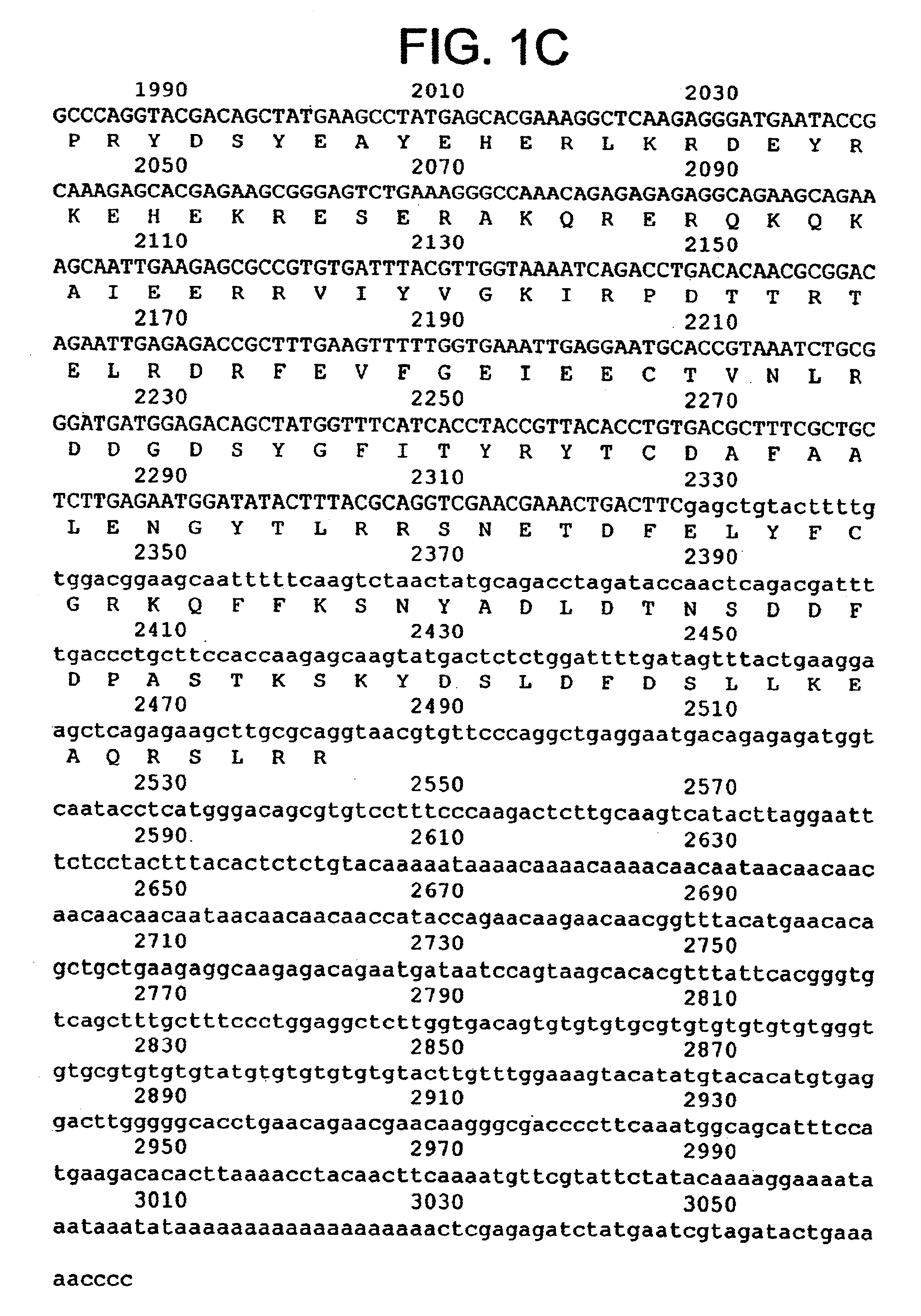PCG-1, a novel brown fat PPARγ coactivator
- Summary
- Abstract
- Description
- Claims
- Application Information
AI Technical Summary
Benefits of technology
Problems solved by technology
Method used
Image
Examples
example i
Identification and Characterization of Mouse PGC-1
[0162]The mouse HIB 1B cell line (Ross, R. et al. (1992) Proc. Natl. Acad. Sci. USA 89:7561-7565), a brown adipocyte cell line which expresses UCP, was differentiated and treated with isoproterenol to induce UCP expression. A cDNA library from the mouse HIB 1B cell line was screened in a yeast two hybrid system using PPARγ bait and Clontech (Palo Alto, Calif.) reagents. Briefly, amino acids 183-505 of the murine PPARγ were cloned in-frame into the GAL4 DNA-binding domain plasmid pAS2. HIB 1B cDNA expression library was constructed in the GAL4 activation domain plasmid pACT II. The yeast two-hybrid system protocol was performed as described in the CLONTECH Matchmaker two-hybrid system protocol. pAS-PPARγ was transformed into Y190 yeast cells by the lithium acetate method and maintained by selection in leucine- plates. A pACT-HIB 1B cDNA library was transformed into Y19 PPARγ yeast cells, and positive clones were assayed for β-galactos...
example ii
Identification of Human PGC-1
[0167]Northern blot analysis of human poly A RNA screened with a mouse full length cDNA probe (e.g., a probe having the sequence shown in SEQ ID NO:1) revealed high levels of expression of PGC-1 in human muscle, heart, brain, kidney and pancreas, with the highest levels of expression detected in human muscle and heart. Accordingly, a human muscle library, e.g., an human skeletal muscle oligo dT primed library (Clontech catalog #HL5023t, lot #7110299), was screened using a full length mouse PGC-1 probe comprising the nucleotide sequence of SEQ ID NO:1 or a portion thereof (e.g., nucleotides from the 5′ region of SEQ ID NO:1, e.g., nucleotides 1-50 of SEQ ID NO:1) (e.g., as described in Sambrook, J., Fritsh, E. F., and Maniatis, T. Molecular Cloning: A Laboratory Manual. 2nd, ed., Cold Spring Harbor Laboratory, Cold Spring Harbor Laboratory Press, Cold Spring Harbor, N.Y., 1989). Several overlapping clones were isolated and sequenced. After several rounds ...
example iii
Tissue Distribution of Mouse PGC-1 and Cold Induction of PGC-1 in Brown Adipose Tissue
[0172]A Northern analysis of mRNA from lung, muscle, liver, heart, kidney, white adipose tissue (WAT), brown adipose tissue (BAT), brain, testis, and spleen tissue from 4 week old mice acclimated at 24° C. using a probe comprising nucleotides 150 to 3066 of SEQ ID NO:1 was performed. Briefly, total RNA was isolated from cultured cells and tissues of mouse by guanidine isothiocyanate extraction. RNA samples were processed as previously described (Tontonoz et al. (1994) Genes Dev. 8:1224-1234). Three bands appeared on the Northern blots that were larger than the 28S (5000-6000 bp) marker. These bands most likely represent different isoforms of PGC-1. PGC-1 mRNA was detected predominantly in brain, heart, kidney, and BAT. In addition, a minor species of approximately 8 kb is also observed in all of these tissues. In contrast, no PGC-1 mRNA expression is observed from white fat, lung, skeletal muscle, ...
PUM
| Property | Measurement | Unit |
|---|---|---|
| Temperature | aaaaa | aaaaa |
| Temperature | aaaaa | aaaaa |
| Fraction | aaaaa | aaaaa |
Abstract
Description
Claims
Application Information
 Login to View More
Login to View More - R&D
- Intellectual Property
- Life Sciences
- Materials
- Tech Scout
- Unparalleled Data Quality
- Higher Quality Content
- 60% Fewer Hallucinations
Browse by: Latest US Patents, China's latest patents, Technical Efficacy Thesaurus, Application Domain, Technology Topic, Popular Technical Reports.
© 2025 PatSnap. All rights reserved.Legal|Privacy policy|Modern Slavery Act Transparency Statement|Sitemap|About US| Contact US: help@patsnap.com



